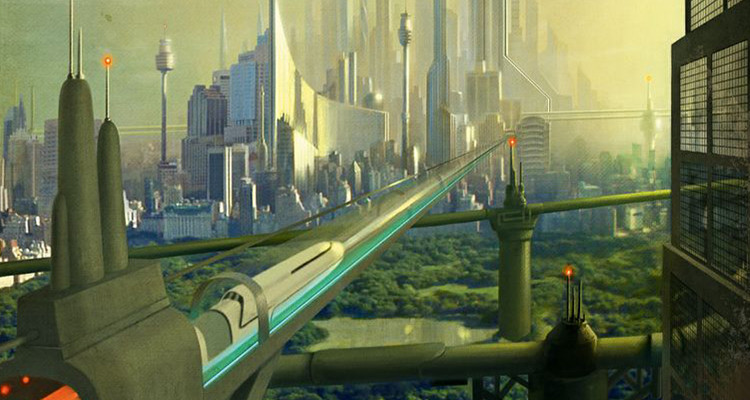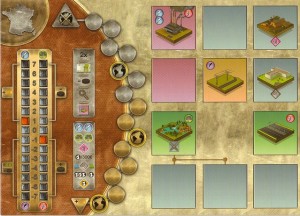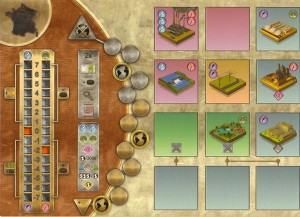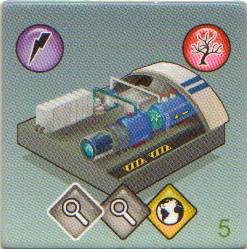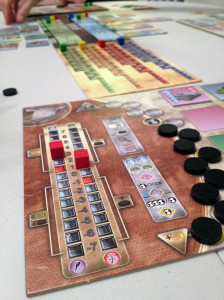INTRODUCTION
Poised at the helm of an expanding nation, do you have what it takes to guide it into greatness? In Prosperity, you must balance the ever-growing demand for energy, research, and production versus a healthy ecology and the rising threat of pollution. Working your way through the seven decades from 1970 to the future of 2030, the goal is to grow the prosperity of your nation and rise above all others.
DESIGN
Prosperity is a game by Reiner Knizia (Ra, Blue Moon, Taj Mahal, and many, many others) & Sebastian Bleasdale (Keyflower) and published by Ystari Games. A tile-drafting and tableau-building game for 2-4 players, a typical game should last you about an hour once everybody knows the basics.
The components are generally of a good quality; thick stock for the tiles that is unlikely to separate, and well made game boards that should last under the pressure. Unfortunately, the paper money is thin and has a habit of sticking together.
Two different styles of art are present in this game, from the rather minimalistic, Sim-City-esqe graphics used for the technology tiles, to the more conventional work used for the research and player boards. While the simplicity of the tiles is a boon for easily understanding the effect of the pieces on the board, the lack of any indication of what you just researched and built (there’s a list in the rulebook) contributes to the feeling of balancing a checkbook. Instead of being able to say: “I’ll research this solar-power plant, netting me two energy and offsetting the ecological hit from my transportation system”, it’s: “I guess I’ll buy this 2-energy / 1-ecology tile.” A personal feeling, I’ll readily admit, but it does end up bothering me slightly.
GAMEPLAY
Each player board is identical except for the supposed country they are representing, and each one has a silver (Easy) and black (Difficult) side. The silver side of the board contains a more generous pollution track, and the pre-built buildings are minimal. The black side, however, begins your country significantly in the hole in regards to both Energy and Ecology. Each board has a number of slots that are colour-coded for the type of building that may be placed there, and the available slots are generalized as Powerplant (pink), Supply (brown), Transport (green) and Infrastructure (blue), with several slots being unavailable until a corresponding Transport tile is placed.
To begin the game, each player receives €200, places their Energy and Ecology markers on the red spots on the respective track, and adds pollution discs to the board until the gold spaces are covered. The research board is seeded with 24 technology tiles, two for each level and track, while an ordered stack of the remaining tiles is formed by decade. This technology stack contains 36 tiles, divided into 5-tile decades, with an additional tile included during the final decade of 2030. At the start of each turn, the top tile from the technology stack is flipped over and scored, depending on which of the five symbols is highlighted on the tile. Each symbol will be tallied once per decade, except one additional Prosperity (VP) tile will be scored in the final years.
Scoring for the highlighted symbol is based on the number of visible occurrences on your player board, so you will gain either VPs, cash, or steps on the research track for each Prosperity, Capital, and Research symbol respectively. For Ecology And Energy, however, your net values; either positive or negative, are taken into account. With a positive Energy value, you are producing more energy than your country can use, and will gain additional cash depending on the surplus. A negative value, on the other hand, forces you to either spend cash or increase the pollution level on your board. If the pollution level is too high, you are prohibited from scoring any Prosperity, while a lower level will uncover previously hidden Prosperity symbols on the track, giving you additional VPs during the scoring rounds. When scoring a positive Ecology value, you remove that many discs from the track, while a negative value will add additional discs. There is no maximum limit to the pollution levels that one can reach, so caution is warranted when running a deficit. If you are required to remove additional discs after the track is empty, then you gain a bonus of €50 in lieu of each excess disc.
After the technology tile is scored, it is placed alongside the research track according to the listed level; higher levels obviously corresponding to either more efficient or simply more powerful tiles. At this point, the player has two actions that they may take from the following list, and the same action may be taken twice:
- Receive €100 from the bank.
- Go up one step on either research track.
- Purchase and place one tile.
- Remove one pollution disc from their track.
Purchasing a tile that is equal to your research level costs €100, while any tile from a lower level is only €50. Higher level technology may also be purchased, at a premium of an extra €100 per level that it exceeds your own. Once purchased, the tile is placed on your player board in a space of the matching colour, either in an empty slot or covering a previously-played tile. In addition to the placeable technology tiles, there are also single-use tiles that are immediately discarded after gaining the listed bonus.
Purchasing a tile that is equal to your research level costs €100, while any tile from a lower level is only €50.
Higher level technology may also be purchased, at a premium of an extra €100 per level that it exceeds your own. Once purchased, the tile is placed on your player board in a space of the matching color, either in an empty slot or covering a previously-played tile. In addition to the place able technology tiles, there are also single-use tiles that are immediately discarded after gaining the listed bonus.
The research board contains two separate tracks for Ecology / Energy, with the available technologies towards the respective themes on either side. On the Ecology side, tiles will generally contain a mixture of Research and Ecology-granting technologies, while the opposite track contains a higher concentration of Energy and Capital tiles, with Prosperity appearing to be equally available along both tracks. When gaining research points, the player chooses which track to move on, and may split the points between tracks. Each successive research level requires additional steps to reach, while a mere two points may let you reach the second level, higher-ranked technologies will be harder to reach
Play continues as outlined above until the final tile is drawn; at that point, the active player finishes their turn and everyone tallies up one final turn of scoring. This time around, the effects of Energy and Ecology scores are doubled, and after scoring Capital, any cash on hand is converted to VPs at a €300 to 1 ratio. The final scoring for Research moves each player up an equal amount on both tracks, with the leader on either track receiving additional VPs. Prosperity is scored one final time, and as you’d expect, the player with the highest VP value is declared victorious.
OVERALL EXPERIENCE
One thing that an effective player will quickly realize is the need for balance; with the opportunities for scoring each particular symbol only showing up once per decade, you want to try building up so that something positive happens each round. However, knowing this, it is also entirely possible to take the risk of driving your ecology into the ground if you don’t expect that tile to be drawn again before it gets back around to your turn.
If the name ‘Reiner Knizia’ sends a tingle down your spine, you’ll likely enjoy this game. If you’re looking for a healthy helping of theme on top of your spreadsheet, however, you may wish to pass this along.
LEAGUE RULING
Smee’s Two Pence
While this game is certainly playable with the stated 2-4 players, the dynamics change drastically in a two player match due to the set turn length of the overall game. It is certainly easier to optimize your country having 18 turns apiece, instead of the 9 you would receive in a four-player setting. During several head-to-head games, the last few turns felt pointless, given that placing any new tiles would skew my country into undesirable negatives going into the final scoring. Speaking of scoring, there is a separate track for each player, rising in an unneeded zig-zag pattern. The scores are admittedly likely to be tied for the first several times around the board, but I feel that these tracks could have been easily unified.
In total, I’ll award Prosperity one thumbs up, along with 4 stars.
Buns
Prosperity looks like Windows 98 and plays like Microsoft Excel. It’s an economic game, but not the kind where you trade goods or auction off new technology. It’s a game about balance, careful decision making, and minimizing risk – which is actually fairly appropriate given the theme of the game. What Prosperity lacks in flash, it makes up for in solid mechanics and a simplified design. Once you understand the simple rule set, you’ll easily fall into the puzzle that is optimizing your nation’s output. This isn’t the type of game that will top many of my LoNG lists, but, in a game group that often appreciates a low-conflict Euro-game, this one isn’t a bad option. There are others within the same category that I would choose first, but the game has redeeming qualities in that it plays quickly and is easy to understand. I could see using it to ease the transition into heavier Euro games. I rate it a solid 3 stars because it’s a good game, it just isn’t particularly captivating.
Ben
Prosperity is a puzzle that involves balancing pros and cons with great timing. There are only a few things you can do on your turn, which end up being dictated by the current balance you have. Because of this, you get a pretty good idea of what you need to do on your turn and, in a 4-player game, you have time to figure out what that is. If this involves purchasing a tile, someone else might screw with those plans, but I found it easy to adapt. I do see the issue with a 2-player game, because even with 4 players many of the options seemed worthless on the last turn. The scoring track was something I definitely did not like in this game. It could have been one track for all players and would have ended up being a lot easier to manage. Overall, between the puzzle aspect of the game keeping me constantly engaged and the fairly quick playtime, I was able to enjoy this game.
naD
Prosperity was a game I had not heard much about until my longtime gaming partner Smee brought it to my attention. The names Knizia and Bleasdale peaked my interest immediately and the box art was cool. The art style of the actual components however is bland in my opinion. The tiles look like screen caps of Sim City SNES. And lets talk about the paper money. While I love that it looks like little Euro notes, the quality itself is sub-par for a $50 game; appearing to have been printed on run-of-the-mill Office Depot printing paper. Aesthetics out of the way, the mechanics for this title are very streamlined and easy to understand. In the four player game I took part in, players had 9 turns with which to crack their nation’s conundrum and find a thriving balance between ecology and energy all while generating capital and gaining victory points using the limited space they are granted. No small task. As with most economic games, I enjoyed the puzzle put before me and would be happy to give it another try if the opportunity arises. But at the end of the day, I think I would prefer to play a game of Suburbia.

